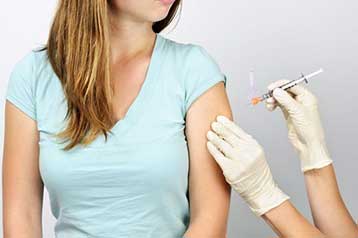Human Papillomavirus Associated Cancers
United States, 2004–2008
Oncogenic human papillomavirus (HPV) has a causal role in nearly all cervical cancers and in many vulvar, vaginal, penile, anal, and oropharyngeal cancers (1).
Most HPV infections clear within 1–2 years, but those that persist can progress to precancer or cancer.
In the United States, public health prevention of cervical cancer includes both secondary prevention through cervical cancer screening and primary prevention through HPV vaccination.
Transmission of HPV also can be reduced through condom use and limiting the number of sexual partners.
Two vaccines (bivalent and quadrivalent) are available to protect against HPV types 16 and 18, which are responsible for 70% of cervical cancers. HPV 16 also is the most common HPV type found in the other five cancers often associated with HPV (2).
To assess the incidence of HPV-associated cancers (i.e., cancers at specific anatomic sites and with specific cell types in which HPV DNA frequently is found), CDC analyzed 2004–2008 data from the National Program of Cancer Registries (NPCR) and the Surveillance, Epidemiology, and End Results (SEER) program. During 2004–2008, an average of 33,369 HPV-associated cancers were diagnosed annually (rate: 10.8 per 100,000 population), including 12,080 among males (8.1 per 100,000) and 21,290 among females (13.2).
Multiplying the counts for HPV-associated cancers by percentages attributable to HPV (3), CDC estimated that approximately 26,000 new cancers attributable to HPV occurred each year, including 18,000 among females and 8,000 among males. Population-based cancer registries are important surveillance tools to measure the impact on cancer rates of public health interventions such as vaccination and screening.
CDC analyzed NPCR and SEER data on cancers diagnosed during 2004–2008 in 50 states and the District of Columbia (data covering 100% of the U.S. population are now available through expansion of NPCR) (4). Case definitions based on expert consensus were used to examine the burden of invasive cancers at anatomic sites (cervix, vulva, vagina, penis, anus, and oropharynx [5]) and for cell types (carcinoma of the cervix and squamous cells for the other sites) in which HPV DNA is frequently found. Inclusion of oropharyngeal cancers as HPV-associated was further limited to specific sites where HPV is most likely to be found: base of tongue, tonsils, and "other oropharynx" (5).
Cancer data were analyzed by sex, age, race, Hispanic ethnicity, and state of residence. Race categories included white, black, Asian/Pacific Islander, and American Indian/Alaska Native; ''all races'' included other and unknown categories. American Indian/Alaska Native data were enhanced by linkage with Indian Health Service administrative records (4). Hispanic ethnicity included persons of any race who were identified as being Hispanic in the medical record or by use of an algorithm* (4). Age-adjusted incidence rates were calculated per 100,000 persons in SEER*Stat† and were standardized to the 2000 U.S. Standard Population. Significant differences in rates were limited to comparisons at p<0.05. Because HPV-associated cancers defined by cell type and specific anatomic site might include cancers not caused by HPV, and because cancer registries typically do not capture information on HPV infection status, for this analysis, the average annual number of HPV-associated cancers was multiplied by the percentage of each cancer type found attributable to HPV based on genotyping studies (3).
Overall, an average of 33,369 HPV-associated cancers (10.8 per 100,000 population) were diagnosed annually: 21,290 among females (13.2) and 12,080 among males (8.1). Cervical cancer was the most common of these cancers, with an average of 11,967 cases annually; oropharyngeal cancer was the second most common, with an average of 11,726 cases annually (2,370 among females and 9,356 among males) (Tables 1 and 2). The rate of anal cancer among females (1.8 per 100,000) was higher than among males (1.2). The rate of oropharyngeal cancer among males (6.2) was four times that among females (1.4). Rates of cervical and penile cancer were higher among blacks (9.9) and Hispanics (11.3), when compared with whites (7.4) and non-Hispanics (7.4); however, the rate of vulvar cancer was lower among blacks (1.4) and Hispanics (1.2) than among whites (1.9) and non-Hispanics (1.9). Anal cancer in females was highest among whites (2.0), whereas rates in males were highest among blacks (1.6). For both sexes, rates of oropharyngeal cancer were higher among whites (males: 6.4, females: 1.4) and blacks (males: 6.3, females: 1.4) than other races (Table 1).
Rates varied by state, with rates of HPV-associated cancers combined ranging from 8.5 per 100,000 (Utah) to 16.3 (West Virginia) among females, and from 4.9 (Utah) to 11.6 (District of Columbia) among males. Although rates varied by anatomic site, some states had lower or higher rates across cancer sites. Maryland, Colorado, and Utah had cancer rates in the lowest tertile for most or all HPV-associated cancers, whereas Kentucky, Louisiana, and Tennessee had rates in the highest tertile for most of the cancer sites.§
Multiplying the number of HPV-associated cancers by the percentages attributable to HPV (3), CDC estimated that approximately 26,000 new cancers attributable to HPV occurred each year: 18,000 among females and 8,000 among males (Table 2). Cervical and oropharyngeal cancers were the most common of these, with an estimated 11,500 cervical cancers and 7,400 oropharyngeal cancers (5,900 among men and 1,500 among women).
Reported by
Xiaocheng Wu, MD, Louisiana Tumor Registry. Meg Watson, MPH, Reda Wilson, MPH, Mona Saraiya, MD, Div of Cancer Prevention and Control; Jennifer L. Cleveland, DDS, Div of Oral Health, National Center for Chronic Disease Prevention and Health Promotion; Lauri Markowitz, MD, Div of STD Prevention, National Center for HIV/AIDS, Viral Hepatitis, STD, and TB Prevention, CDC. Corresponding contributor: Meg Watson, eze5@cdc.gov, 770-488-3097.
Editorial Note
The results of this analysis determined that an estimated average of 21,290 HPV-associated cancers occurred among females each year during 2004–2008, making these cancers combined more common than ovarian cancers and nearly as common as melanoma among females.¶ The combined burden among men was smaller, with an average of 12,080 cases per year, roughly equivalent to the number of invasive brain cancers occurring annually among men. Many HPV-associated cancers likely are preventable through the use of HPV vaccine.
Two vaccines (bivalent and quadrivalent) are available to protect against HPV 16 and 18, the types that cause most cervical and other anogenital cancers as well as some oropharyngeal cancers. Data from clinical trials have shown that both vaccines prevent cervical precancers; quadrivalent vaccine also has been shown to prevent vaginal, vulvar, and anal precancers. Because HPV 16 is responsible for the majority of noncervical cancers caused by HPV, the vaccines also might protect against other HPV-associated cancers. The Advisory Committee on Immunization Practices recommends routine vaccination of females aged 11 or 12 years with 3 doses of either vaccine and routine vaccination of males aged 11 or 12 years with 3 doses of quadrivalent vaccine** (6). Catch-up vaccination is recommended for females through age 26 years and for males through age 21 years. In 2010, 32% of females aged 13–17 years had received 3 doses of HPV vaccine††(2).
Most cases of invasive cervical cancer are preventable with regular screening for precancerous lesions (e.g., by Papanicolaou test) and follow-up of abnormal results. A recent analysis of data from the National Health Interview Survey found an overall cervical cancer screening rate of 83%, with lower rates among Asian, American Indian/Alaska Native, Hispanic, and foreign-born women (7). Higher rates of cervical cancer among black and Hispanic women might be the result, in part, of reduced access to screening and/or follow-up care (8). If smaller percentages of adolescent girls in the same demographic groups receive HPV vaccine, disparities in cervical cancers might increase (2). Cervical cancer screening guidelines recently changed in the United States, with guidelines now recommending screening intervals of 3 years, if screening with a Papanicolaou (Pap) test alone for women aged ≥21 years, or 5 years if screening with a Pap test and an HPV DNA test, which is an option for women aged ≥30 years (9).
Reasons for variations in rates of noncervical HPV-associated cancers by race/ethnicity and state are not clear but might be attributable, in part, to demographics, screening practices, tobacco use, or other factors related to HPV infection or persistence. Although analysis of oropharyngeal cancers was limited to cancer at specific anatomic sites most likely to be HPV-associated, variations in incidence of these cancers might be attributable to variations in smoking and alcohol use rather than, or in combination with, HPV infection. Studies on whether oral HPV infection interacts with these exposures to further increase the risk for oropharyngeal cancer are inconclusive (10). Population-based screening for noncervical HPV-associated cancers generally is not recommended.
The findings in this report are subject to at least three limitations. First, although population-based cancer registries provide a reliable system for counting invasive cancers, they typically do not capture information on HPV status or risk factors such as smoking. Not all cancers termed "HPV-associated" reflect actual HPV infections, and the numbers judged to be HPV-attributable are only estimates. Second, reporting of race and ethnicity uses data from medical records, which might be inaccurate in a small proportion of cases. Finally, current requirements for reporting cancer registry data are rigorous and require multiple steps; therefore, the most recent data are several years old.
Of the 33,369 cancers that occur each year in the United States at anatomic sites associated with HPV, approximately 26,000 can be attributed to HPV and might be preventable through the use of HPV vaccine. Ongoing surveillance of HPV-associated cancers using high-quality population-based registries is needed to monitor trends in cancer incidence that might result from increasing use of HPV vaccines, changes in cervical cancer screening practices, and changes in behaviors that increase risk for HPV infection, persistence, or progression.
References
- International Agency for Research on Cancer. Monographs on the evaluation of carcinogenic risks to humans. Volume 90: human papillomaviruses. Lyon, France: World Health Organization, International Agency for Research on Cancer; 2007.
- CDC. National and state vaccination coverage among adolescents aged 13 through 17 years—United States, 2010. MMWR 2011;60:1117–23.
- Gillison ML, Chaturvedi AK, Lowy DR. HPV prophylactic vaccines and the potential prevention of noncervical cancers in both men and women. Cancer 2008;113(10 Suppl):3036–46.
- CDC. United States Cancer Statistics (USCS) 1999–2007 cancer incidence and mortality data. Atlanta, GA: US Department of Health and Human Services, CDC; 2012. Available at http://www.cdc.gov/uscs. Accessed April 25, 2012.
- Watson M, Saraiya M, Ahmed F, et al. Using population-based cancer registry data to assess the burden of human papillomavirus–associated cancers in the United States: overview of methods. Cancer 2008;113:2841–54.
- CDC. Recommendations on the use of quadrivalent human papillomavirus vaccine in males—Advisory Committee on Immunization Practices (ACIP), 2011. MMWR 2011;60:1705–8.
- CDC. Cancer screening—United States, 2010. MMWR 2012;61:41–5.
- Benard VB, Lawson HW, Eheman CR, Anderson C, Helsel W. Adherence to guidelines for follow-up of low-grade cytologic abnormalities among medically underserved women. Obstet Gynecol 2005;105(6):1323–8.
- US Preventive Services Task Force. Screening for cervical cancer. Rockville, MD: US Preventive Services Task Force; 2012. Available at http://www.uspreventiveservicestaskforce.org/uspstf/uspscerv.htm
. Accessed April 16, 2012. - Smith EM, Rubenstein LM, Haugen TH, Hamsikova E, Turek LP. Tobacco and alcohol use increases the risk of both HPV-associated and HPV-independent head and neck cancers. Cancer Causes Control 2010;21:1369–78.
Content source:
Centers for Disease Control and Prevention
Related Articles
-
Human Papillomavirus
-
Human Papillomavirus Vaccines: Questions and Answers
-
Human Papilloma Virus Signs and Symptoms
-
Human Papillomavirus Screening
-
Human Papillomavirus Treatment
-
Human Papillomavirus Prevention
-
Human Papillomavirus and Men
-
HPV and Men
-
Human Papillomavirus Infection Treatment
-
Human Papillomavirus Vaccine
-
Human Papillomavirus and Genital Warts
-
Human Papillomavirus Associated Cancers
United States, 2004–2008 -
Preventing Cervical Cancer Worldwide (PDF document)
-
FDA Advisory Panel Recommends Human Papillomavirus Vaccine






